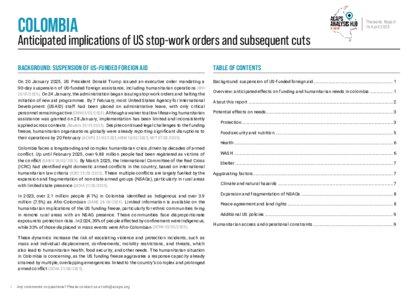The picture below illustrates how the US Government's decision to end humanitarian aid globally has played out, based on perspectives gathered at the country level. From February–March 2025, ACAPS, together with the International Council of Volunteer Agencies, organised five live sessions and expert discussions, gathering a total number of 117 participants working in the Democratic Republic of Congo (DRC), Somalia, South Sudan, Sudan, and Syria. The visual summarises the outcome of these sessions.
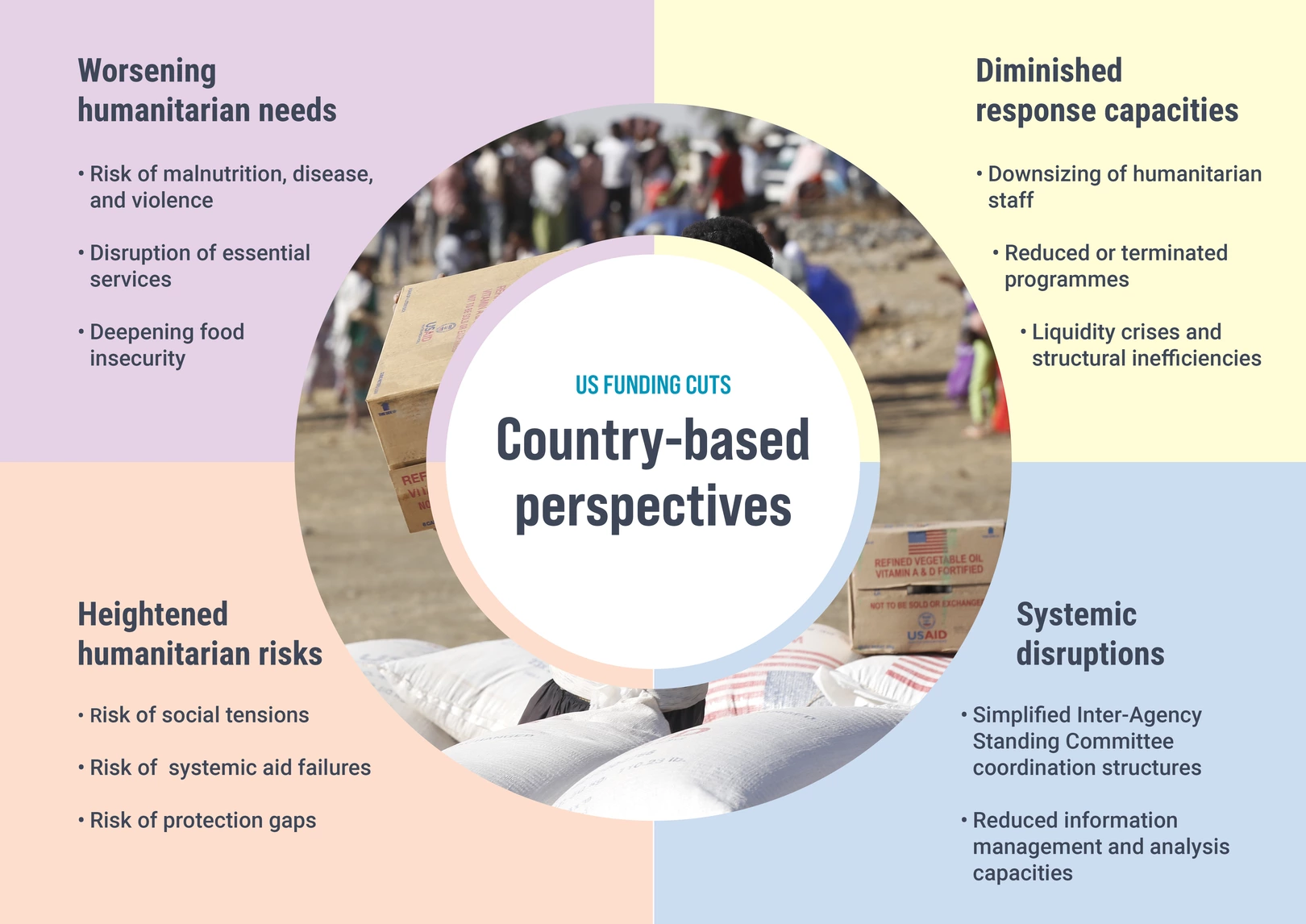
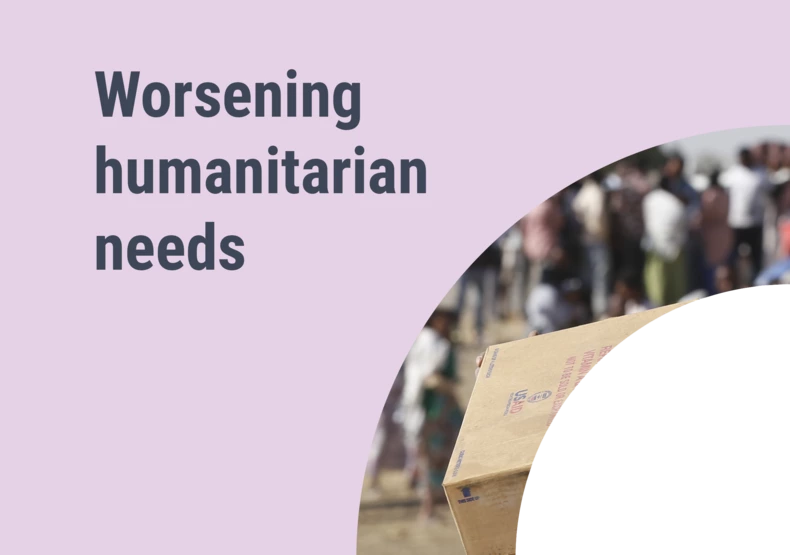
Risk of malnutrition, disease, and violence
Risk of malnutrition, disease, and violence
In Syria, 6.7 million people, including pregnant and lactating women and children under five, face nutrition gaps, while the suspension of WASH services heightens the risk of disease (Syria live session 27/02/2025).
In Sudan, preventative programmes, including vaccinations and community health awareness, have ceased, increasing risks of malnutrition and disease, especially for malnourished children, pregnant women, and people with chronic illnesses (Sudan live session 06/03/2025).
In the DRC, funding cuts have worsened conditions for women, girls, and IDPs, increasing risks of gender-based violence (including sexual), while the loss of protection services has left populations more exposed (DRC live session 11/03/2025).
Disruption of essential services
Disruption of essential services
In Syria, 56 hospitals have closed, and WASH services for over one million people have been suspended, creating humanitarian dead zones and reversing previous gains (Syria live session 27/02/2025).
In Somalia, the funding cuts have led to the widespread closure of critical health facilities, severely affecting access to health and education services, especially in marginalised and hard-to-reach areas (Somalia live session 17/03/2025).
In South Sudan, funding reductions have disrupted cluster coordination and programme continuity, pushing major organisations towards shutdowns, especially in WASH and other essential sectors (South Sudan live session 05/03/2025).
DEEPENING FOOD INSECURITY
DEEPENING FOOD INSECURITY
In Syria, food and cash assistance has been halted for 16,000 people, significantly increasing hunger risks and reversing food security gains (Syria live session 27/02/2025).
In Sudan, funding cuts have worsened food security conditions, especially among IDPs, refugees, and households headed by women, leaving people without basic food support (Sudan live session 06/03/2025).
In the DRC, essential services in the food security sector have been severely disrupted, particularly in Goma, contributing to immediate food access challenges (DRC live session 11/03/2025).
Downsizing of humanitarian staff
Downsizing of humanitarian staff
In Syria, NGOs are restructuring amid uncertainty and reducing crucial field staff, severely weakening response efforts and limiting reach in critical sectors (Syria live session 27/02/2025).
In the DRC, INGOs are experiencing major staff downsizing, resulting in diminished operational effectiveness, particularly in high-risk zones (DRC live session 11/03/2025).
In Somalia, the cuts have reduced essential staffing, heightening insecurity and limiting humanitarian access to vulnerable communities (Somalia live session 17/03/2025).
Reduced or terminated programmes
Reduced or terminated programmes
In Sudan, nearly 80% of communal kitchens have shut down because of funding gaps, undermining food assistance and weakening community-level support structures (Sudan live session 06/03/2025).
In South Sudan, funding cuts have led to imminent program shutdowns, especially in crucial sectors such as WASH, creating serious gaps in basic service delivery (South Sudan live session 05/03/2025).
In Syria, sectors including health, food security, and WASH face suspensions, directly affecting treatment access and nutrition outcomes (Syria live session 27/02/2025).
Liquidity crises and structural inefficiencies
Liquidity crises and structural inefficiencies
In South Sudan, international organisations are facing cash depletion, with structural inefficiencies and resource constraints complicating efforts to maintain operations (South Sudan live session 05/03/2025).
In Sudan, local organisations are grappling with coordination breakdowns and information silos, driven by funding instability and operational inefficiencies, especially in conflict zones (Sudan live session 06/03/2025).
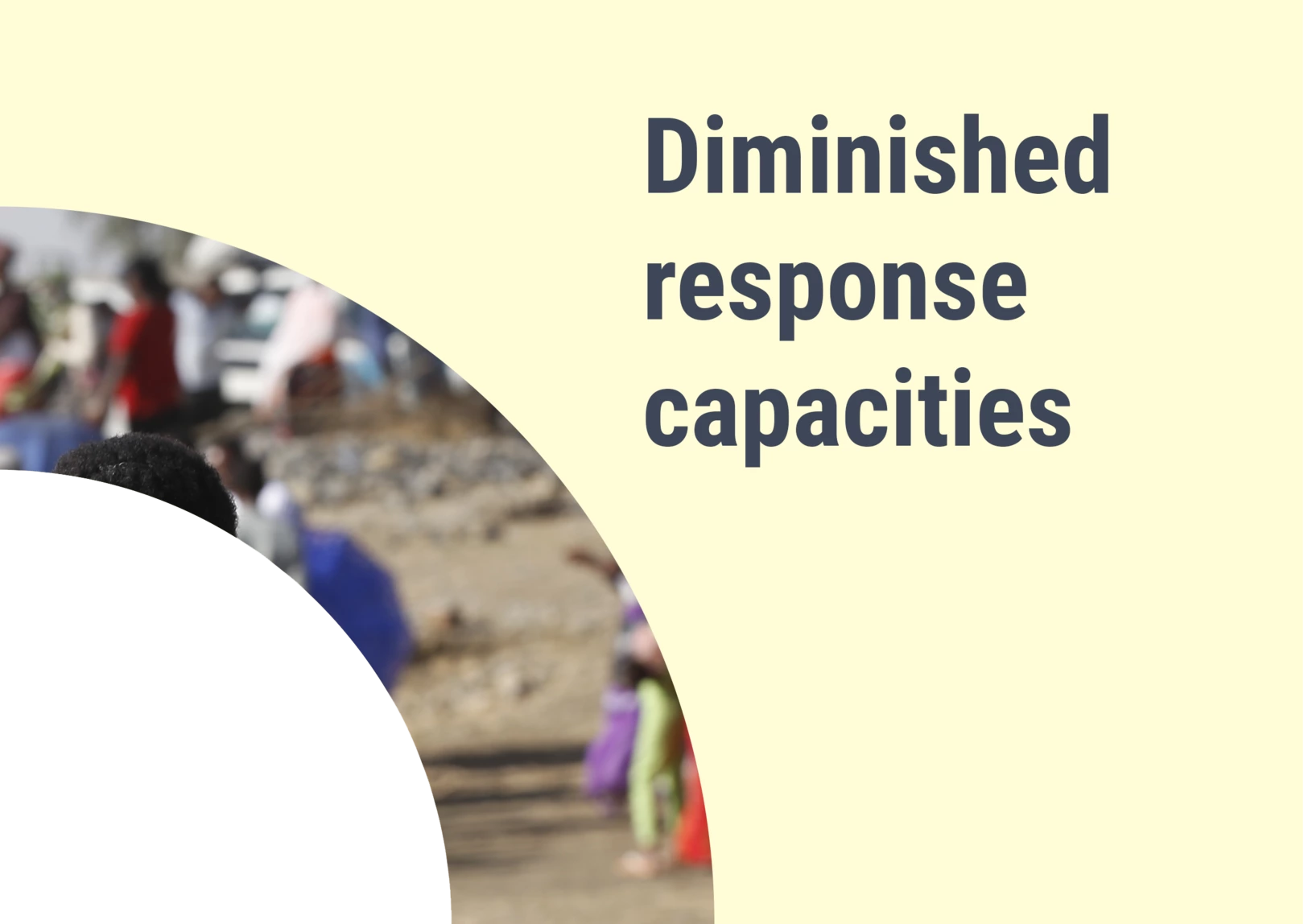
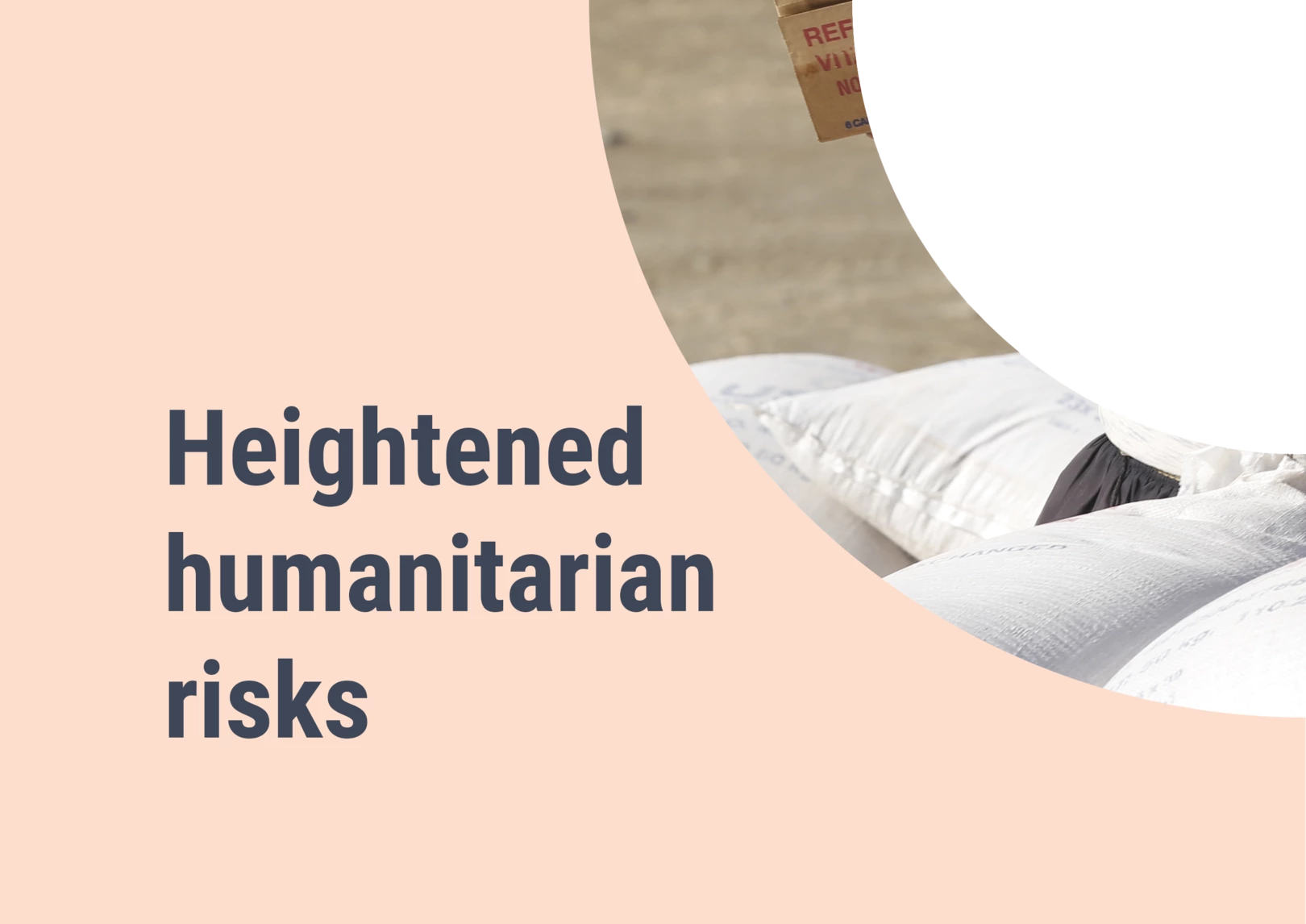
Risk of social tensions
Risk of social tensions
In Somalia, the disruption of peacebuilding and resilience programmes resulting from aid cuts is escalating local conflicts over dwindling resources, worsening clan-based tensions and undermining local government functions (Somalia live session 17/03/2025).
In Sudan, diminished advocacy and disrupted market monitoring caused by funding cuts are increasing instability, especially as access constraints and vulnerability deepen tensions among communities (Sudan live session 06/03/2025).
In the DRC, funding confusion and the abrupt termination of programmes are aggravating trust issues and social fragility, especially in politically sensitive areas where conflict and humanitarian needs intersect (DRC live session 11/03/2025).
Risk of systemic aid failures
Risk of systemic aid failures
In Syria, the collapse of coordination forums, especially in Northeast Syria, is threatening systemic failure of the response architecture. Fragmented responses, payment issues, and reduced local capacity reflect the broader breakdown (Syria live session 27/02/2025).
In South Sudan, critical reductions in staff and resources are pushing the humanitarian response system towards collapse, with escalating needs and diminished operational effectiveness across multiple sectors (South Sudan live session 05/03/2025).
In the DRC, key programmes in food, nutrition, cholera, and Ebola response are at risk of collapse, endangering basic service delivery and exposing systemic weaknesses, especially under continued political and funding pressure (DRC live session 11/03/2025).
Risk of protection gaps
Risk of protection gaps
In the DRC, protection programmes, including those addressing sexual exploitation and abuse, are under threat of suspension, risking critical gaps in safeguarding vulnerable populations (DRC live session 11/03/2025).
In Somalia, funding cuts have forced reductions in gender-based violence response programmes, heightening risks to women and girls in already insecure environments, and increased child labour and reduced education access are further widening protection gaps (Somalia live session 17/03/2025).
In Sudan, new needs may arise as preventative programmes, such as vaccination campaigns, protection services, and community awareness programmes, have stopped (Sudan live session 06/03/2025).
Reduced information management and analysis capacities
Reduced information management and analysis capacities
In Somalia, cuts have weakened organisations such as the International NGO Safety Organisation, limiting information flows and reducing the capacity for interagency coordination and analysis (Somalia live session 17/03/2025).
In Sudan, the lack of information-sharing and clarity on the impacts of funding cuts has created coordination challenges (Sudan live session 06/03/2025 b).
Simplified Inter-Agency Standing Committee (IASC) coordination structures
Simplified Inter-Agency Standing Committee (IASC) coordination structures
In Somalia, leaving a single-funded coordination cluster until June lacks the robustness required for effective humanitarian response. This compromises strategic coverage and prioritisation (Somalia live session 17/03/2025).
In South Sudan, structural inefficiencies and resource constraints hampering response adjustments may reflect a streamlining or reduction in coordination functions, consistent with simplified structures (South Sudan live session 05/03/2025).
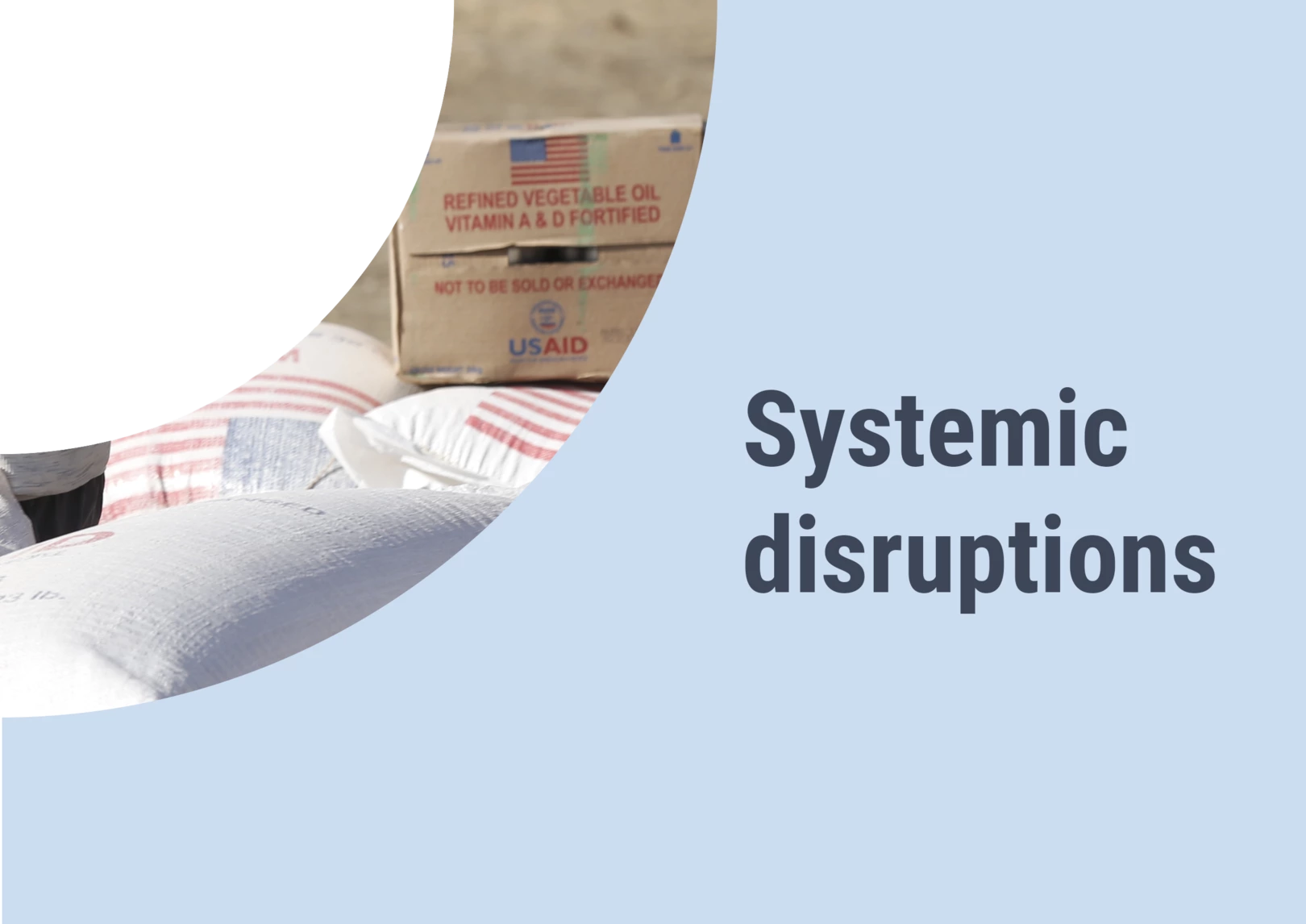
US executive orders and stop-work directives on humanitarian aid have created global uncertainty, with huge impacts on those in need. Constant shifts, misinformation, and unclear policies make it difficult to grasp both the current situation and future consequences. Now more than ever, clear analysis is essential to understanding this crisis.
ACAPS AT HNPW 2025
Flying blind: impact of the US funding freeze on the humanitarian data ecosystem
Alongside colleagues from Ground Truth Solutions, Humanitarian Outcomes, and Here Geneva, we explored how the US funding freeze has disrupted the humanitarian data ecosystem. Our engaging discussion focused on navigating these challenges and identifying new approaches to adapt in these turbulent times.
US AID Freeze dashboard
About the dashboard
About the dashboard
Aims: this dashboard visualises data on key variables to highlight vulnerabilities to the US foreign assistance funding freeze or cuts. This data includes crises severity scores (based on INFORM Severity Index), number of active humanitarian risks by country, financial data, and information on humanitarian needs.
Methodology: the dashboard compiles publicly available data on humanitarian crises severity, humanitarian needs, funding requirements, and humanitarian aid contributions reported to OCHA’s Financial Tracking System (FTS). Information on priority needs per country is based on ACAPS’ Global Analysis Team assessment, drawing from the regular monitoring and analysis of over 140 crises worldwide.
Scope: the dashboard includes data on all countries with active humanitarian crises listed on the INFORM Severity Index. Financial data presented in the dashboard is for humanitarian aid contributions that cover 2023, 2024, and 2025. This does not include development funding or other US foreign funding assistance. Financial data for 2025 is not complete, as the dashboard was published in March 2025 at the beginning of the financial year.
The US fuding cuts have already disrupted lifesaving interventions in Sudan, and will worsen the coverage, scale, and intensity of needs across all sectors, notably food security, health, nutrition, shelter, NFIs, and WASH.
© Gallo images / Getty images
relevant
Country updates
EGYPT
The US funding freeze announced in January 2025 has contributed to global funding shortages, forcing UNHCR to suspend some services, particularly healthcare for refugees in Egypt. Over 20,000 patients have been affected, as all medical treatment has been suspended, except for life-saving procedures. The most affected are the 1.5 million Sudanese refugees in Egypt...
MALAWI
Given reduced funding, WFP may halt assistance to refugees and asylum seekers in Dzaleka refugee camp, the main refugee camp in Malawi, after May 2025. Since February, the funding decline has already led to WFP previously reducing food rations from 75% to 50%...
SYRIA
The US funding freeze announced in January 2025 and subsequent cuts have severely affected humanitarian operations, particularly in informal settlements and IDP camps across Syria. The cuts have reduced people’s access to essential services, including healthcare, water, and food, increasing the risk of disease outbreaks, food insecurity, and social instability...
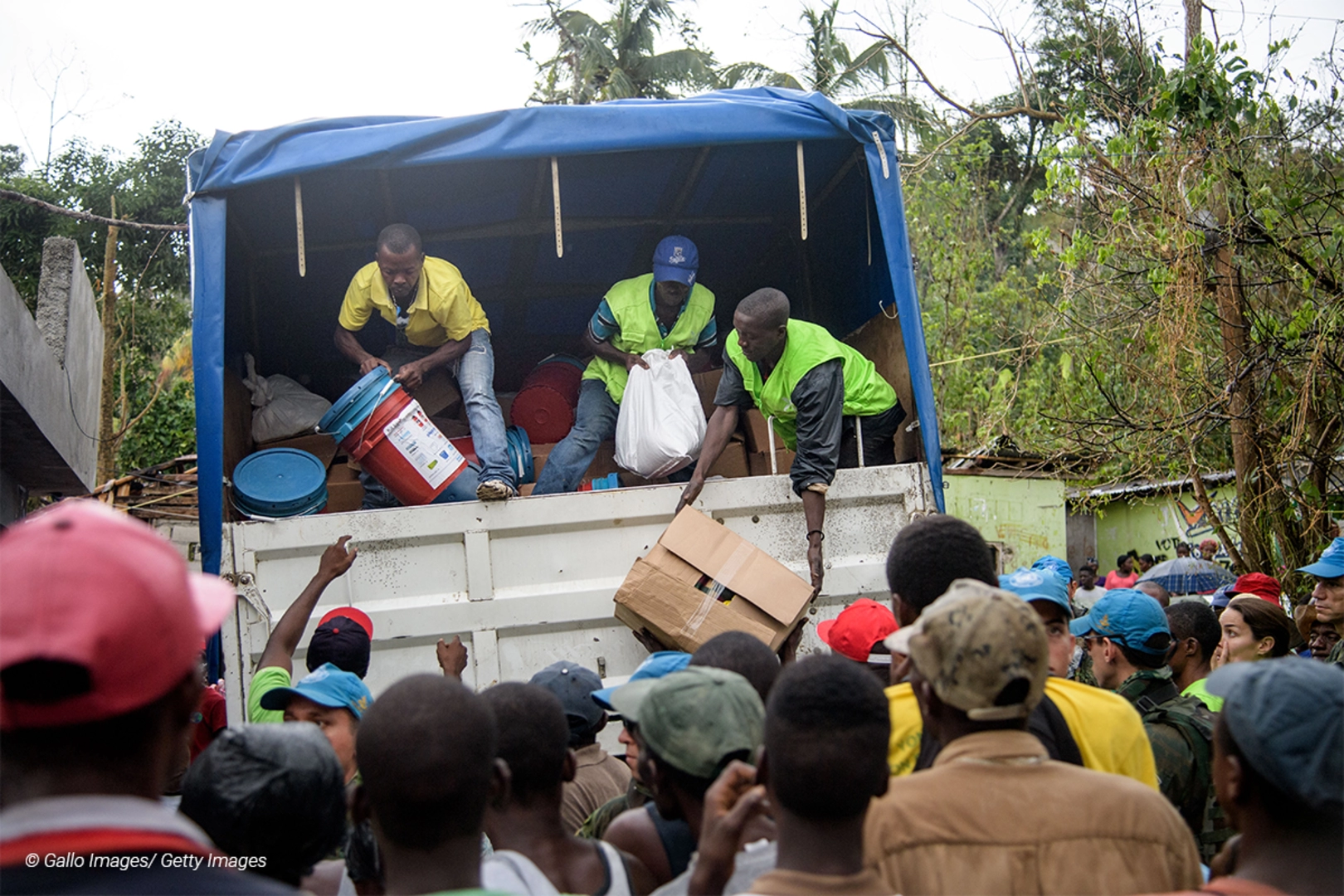
As an independent analysis provider, ACAPS is leading this project through a mix of country-level and global analyses.
Leveraging its expertise and collaborating with key partners, our team aims to enhance analytical capacity, bring analysts together, and foster collective insights.
Analysis products
on
US funding freeze
16 April 2025
Colombia: anticipated implications of US stop-work orders and cuts
DOCUMENT / PDF / 689 KB
This report analyses the current and potential implications of the US funding freeze and stop-work orders on humanitarian operations and needs in Colombia. It aims to provide key stakeholders with an accessible overview of emerging operational and strategic challenges.
01 April 2025
Afghanistan: Implications of the US foreign aid cuts on the humanitarian response
DOCUMENT / PDF / 1 MB
This report builds on ACAPS’ briefing note on what the US aid freeze means to Afghanistan, published on 7 February 2025. It aims to provide a more comprehensive overview of the implications of the US aid freeze and subsequent cuts on humanitarian programming in the country, with a focus on how this affects humanitarian response capacity and Afghans.
31 March 2025
Ukraine: implications of the US foreign aid cuts
DOCUMENT / PDF / 766 KB
This report provides an overview of the implications of the US foreign aid freeze and cuts on humanitarian, development, and government programmes, with a focus on the impacts on humanitarian response capacity and affected communities. It aims to support donor contingency planning and the advocacy efforts of affected organisations.
Attached resources
24 March 2025
Myanmar: implications of the US funding freeze and cuts in the response and health needs
DOCUMENT / PDF / 285 KB
This report analyses the actual (by March 2025) and potential implications of the US funding freeze and cuts on the overall humanitarian response in Myanmar, with a particular focus on national and local organisations. It includes a spotlight on the health sector, which is facing significant cuts amid rising health needs.
13 March 2025
Ethiopia: implications of the US aid freeze & terminations
DOCUMENT / PDF / 1 MB
This report aims to provide a national-level analysis of the implications of the US funding freeze and subsequent terminations of aid for the humanitarian context in Ethiopia to support understanding and decision-making.


